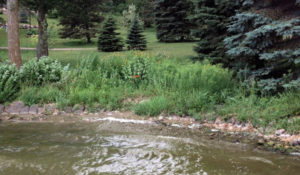Shoreline Restoration
 Are you experiencing a loss of shoreline due to erosion? Do you want to do something proactive to help reduce the green algae bloom on Pickerel Lake? Want to enhance the natural beauty of your property while attracting a variety of wildlife? Has mowing steep slopes or wet spots become a hazard or hassle? If you answered yes to any of these questions, consider the benefits of a shoreline restoration project. Many resources are available to help plan a successful restoration. You may be a candidate to partner with the South Dakota Department of Game, Fish and Parks to restore your shoreline to natural habitat.
Are you experiencing a loss of shoreline due to erosion? Do you want to do something proactive to help reduce the green algae bloom on Pickerel Lake? Want to enhance the natural beauty of your property while attracting a variety of wildlife? Has mowing steep slopes or wet spots become a hazard or hassle? If you answered yes to any of these questions, consider the benefits of a shoreline restoration project. Many resources are available to help plan a successful restoration. You may be a candidate to partner with the South Dakota Department of Game, Fish and Parks to restore your shoreline to natural habitat.
There are several reasons to own natural shoreline habitat:
- Stop erosion by installing native plants. Native species have a root system of up to 14 feet deep, whereas Kentucky blue grass (typical lawn grass) has a root system only a few inches deep.
- Improve water quality by reducing the intensity of algae blooms. A 30 foot wide native plant buffer removes 75-85% of the phosphorus, a major causes algae blooms.
- Provide essential habitat for a variety of fish and wildlife. This could include everything from rearing habitat for crappies to food for butterflies, hummingbirds and leopard frogs.
- Reduce the amount of time spent mowing and other lawn maintenance. This also eliminates the need to use fertilizers and toxic chemicals near the lake.
- Enhance natural beauty, which helps preserve property value.
How You Can Help
Shorelines along some popular South Dakota lakes are being developed at a rapid rate. In some areas, up to 90% of the shoreline no longer has natural, functioning habitat. This may result in the increased frequency and intensity of summer and winter fish kills. What can you do to help improve South Dakota lakes?
Partner with the South Dakota Department of Game, Fish, and Parks by contacting a biologist to see if the “native plant buffer program” is right for you. Highlights of the program include free plants, seed, landscaping blocks, erosion control materials, mulch, installation and technical advice concerning native plantings and erosion control. Please contact Rhet Russell with the SD GF&P Watertown office to assist with your project on Pickerel Lake.
Resources:
- Effects of Nearshore Development
- Shoreline Best Management Practices for Property Owners
- Shoreline Alteration by Rhet Russell 2016
- Landscaping for Wildlife and Water Quality (Beautifully illustrated manual)
- Shoreline Restoration Brochure
- Shoreline Restoration Presentation
- Shoreland Best Management Practices
